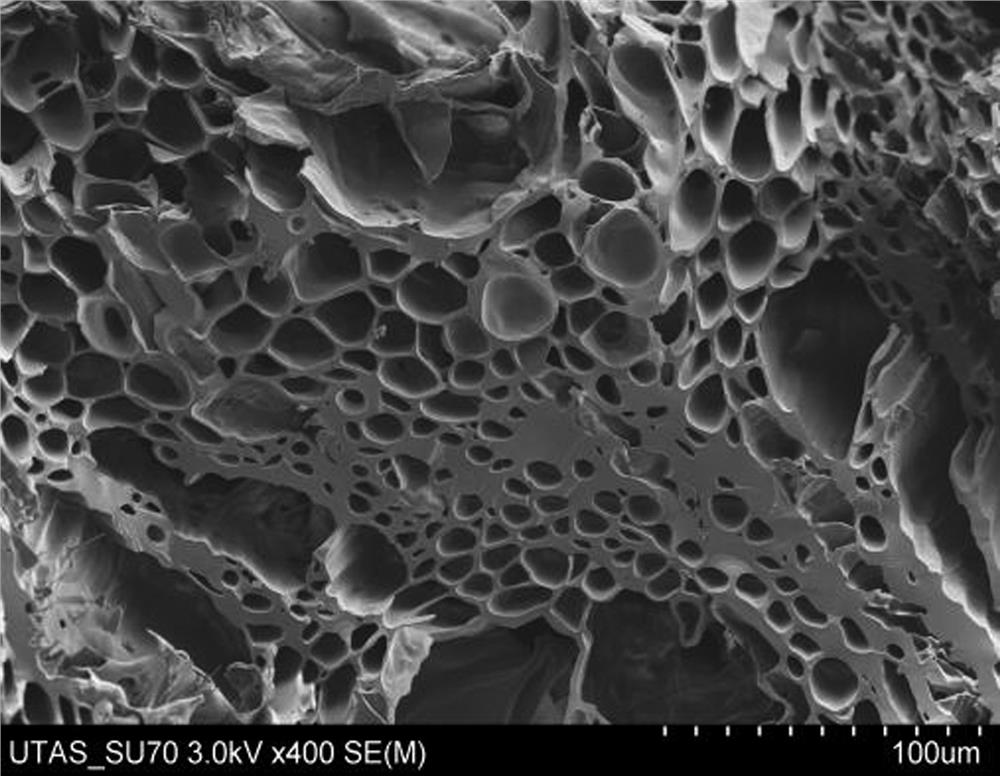Cement-based material carbon sequestration internal curing agent as well as preparation and application thereof
A technology of cement-based materials and curing agents, applied in solid waste management, sustainable waste treatment, climate sustainability, etc., can solve problems such as high cost, insufficient maintenance effect, and few types
- Summary
- Abstract
- Description
- Claims
- Application Information
AI Technical Summary
Problems solved by technology
Method used
Image
Examples
Embodiment 1
[0024] A preparation method of a cement-based material carbon-fixing internal curing agent, the specific steps are as follows:
[0025] (1) Preparation of biochar: Using waste wood as raw material, the wood was cut into cubes, pre-dried in a room with a temperature of 22 °C and a relative humidity of 65%, and then placed in a temperature-controlled muffle furnace for heating. Then, the temperature was raised to 500°C at 10°C / min and then kept for 2 hours to completely carbonize it into biochar, and it was taken out after cooling.
[0026] (2) Biochar modification: block biochar was soaked in saturated lime aqueous solution for 24 h, dried in an oven at 95 °C, and then ground with a flying knife mill for 4 min to obtain modified biochar powder particles.
[0027] The modified biochar powder particles obtained above were mixed into cement mortar with a water-cement ratio of 0.4 instead of 1% cement by mass. Compared with pure cement mortar without internal curing agent, the comp...
Embodiment 2
[0029] A preparation method of a cement-based material carbon-fixing internal curing agent, the specific steps are as follows:
[0030] (1) Preparation of biochar: Using waste wood as raw material, the wood was cut into cubes, pre-dried in a room with a temperature of 22 °C and a relative humidity of 65%, and then placed in a temperature-controlled muffle furnace for heating. Then, the temperature was raised to 700°C at 10°C / min and then kept for 2 hours to completely carbonize it into biochar, and it was taken out after cooling.
[0031] (2) Biochar modification: block biochar was soaked in saturated lime aqueous solution for 48 h, dried in an oven at 95 °C, and then ground with a flying knife mill for 4 min to obtain modified biochar powder particles.
[0032] The modified biochar powder particles obtained above were mixed into cement mortar with a water-cement ratio of 0.5 instead of 5% cement by mass. The flexural strength is increased by 2%, and the autogenous shrinkage ...
Embodiment 3
[0034] A preparation method of a cement-based material carbon-fixing internal curing agent, the specific steps are as follows:
[0035] (1) Preparation of biochar: Using waste wood as raw material, the wood was cut into cubes, pre-dried in a room with a temperature of 22 °C and a relative humidity of 65%, and then placed in a temperature-controlled muffle furnace for heating. Then, the temperature was raised to 500°C at 10°C / min and then kept for 2 hours to completely carbonize it into biochar, and it was taken out after cooling.
[0036] (2) Biochar modification: block biochar was soaked in NaOH solution with a mass concentration of 1% for 24 hours, dried in an oven at a temperature of 95°C, and then ground with a flying knife mill for 4 minutes to obtain a modified biochar. Charcoal powder particles.
[0037] The modified biochar powder particles obtained above were mixed into cement mortar with a water-cement ratio of 0.5 instead of 3% cement by mass. Compared with pure ce...
PUM
 Login to View More
Login to View More Abstract
Description
Claims
Application Information
 Login to View More
Login to View More - R&D
- Intellectual Property
- Life Sciences
- Materials
- Tech Scout
- Unparalleled Data Quality
- Higher Quality Content
- 60% Fewer Hallucinations
Browse by: Latest US Patents, China's latest patents, Technical Efficacy Thesaurus, Application Domain, Technology Topic, Popular Technical Reports.
© 2025 PatSnap. All rights reserved.Legal|Privacy policy|Modern Slavery Act Transparency Statement|Sitemap|About US| Contact US: help@patsnap.com


